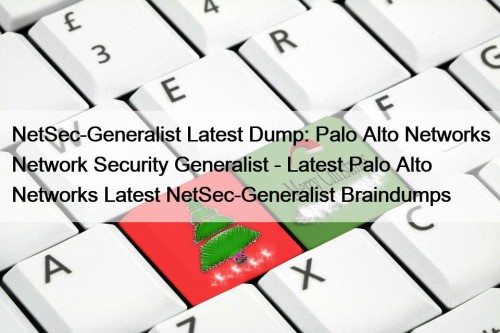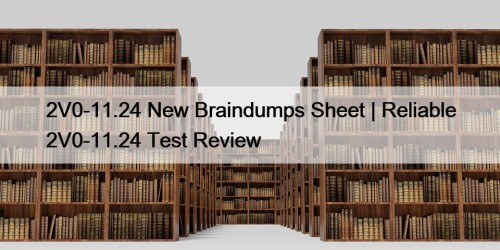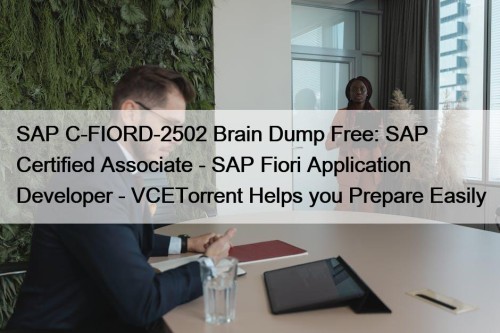Most Popular
 NetSec-Generalist Latest Dump: Palo Alto Networks Network Security Generalist - Latest Palo Alto Networks Latest NetSec-Generalist Braindumps
NetSec-Generalist Latest Dump: Palo Alto Networks Network Security Generalist - Latest Palo Alto Networks Latest NetSec-Generalist Braindumps
IT certification exam cost is really large cost for most ...
 2V0-11.24 New Braindumps Sheet | Reliable 2V0-11.24 Test Review
2V0-11.24 New Braindumps Sheet | Reliable 2V0-11.24 Test Review
Dear, you may think what you get is enough to ...
 SAP C-FIORD-2502 Brain Dump Free: SAP Certified Associate - SAP Fiori Application Developer - VCETorrent Helps you Prepare Easily
SAP C-FIORD-2502 Brain Dump Free: SAP Certified Associate - SAP Fiori Application Developer - VCETorrent Helps you Prepare Easily
Most people said the process is more important than the ...



NetSec-Generalist Latest Dump: Palo Alto Networks Network Security Generalist - Latest Palo Alto Networks Latest NetSec-Generalist Braindumps

IT certification exam cost is really large cost for most candidates in the whole world. Passing exam at first attempt will be everyone's goal. Now our Palo Alto Networks NetSec-Generalist valid exam cram review can help you achieve your goal. Recent years we are engaging in providing 100% pass-rate NetSec-Generalist Valid Exam Cram review for buyers from all over the world, and help thousands of candidates go through exam every year. If you have doubt in your test, let us help you pass exam for sure.
The authoritative, efficient, and thoughtful service of NetSec-Generalist learning question will give you the best user experience, and you can also get what you want with our NetSec-Generalist study materials. I hope our study materials can accompany you to pursue your dreams. If you can choose NetSec-Generalist test guide, we will be very happy. We look forward to meeting you. You can choose your favorite our study materials version according to your feelings. When you use NetSec-Generalist Test Guide, you can also get our services at any time. We will try our best to solve your problems for you. I believe that you will be more inclined to choose a good service product, such as NetSec-Generalist learning question. After all, everyone wants to be treated warmly and kindly, and hope to learn in a more pleasant mood.
>> NetSec-Generalist Latest Dump <<
100% Pass Authoritative Palo Alto Networks - NetSec-Generalist Latest Dump
As the development of the science and technology is fast, so the information of the NetSec-Generalist exam materials changes fast accordingly. The updated version of the NetSec-Generalist study guide will be different from the old version. Some details will be perfected and the system will be updated. You will enjoy learning on our NetSec-Generalist Exam Questions for its wonderful and latest design with the latest technologies applied.
Palo Alto Networks NetSec-Generalist Exam Syllabus Topics:
| Topic | Details |
|---|---|
| Topic 1 |
|
| Topic 2 |
|
| Topic 3 |
|
| Topic 4 |
|
Palo Alto Networks Network Security Generalist Sample Questions (Q50-Q55):
NEW QUESTION # 50
In Prisma SD-WAN. what is the recommended initial action when VoIP traffic experiences high latency and packet loss during business hours?
- A. Configure a new VPN gateway connection.
- B. Disable the most recently created path quality.
- C. Monitor real-time path performance metrics.
- D. Add new link tags to existing interfaces.
Answer: C
Explanation:
VoIP (Voice over IP) traffic is highly sensitive to network conditions, including latency, jitter, and packet loss. In Prisma SD-WAN, maintaining optimal VoIP quality requires dynamic path selection and real-time monitoring of network conditions.
Recommended Initial Action: Monitoring Real-Time Path Performance Metrics When VoIP traffic experiences high latency and packet loss during business hours, the first step is to analyze real-time path performance metrics in Prisma SD-WAN's monitoring dashboard.
Why Real-Time Monitoring is Crucial?
Identifies the Affected Links - Prisma SD-WAN continuously monitors path quality metrics for each available WAN link (e.g., MPLS, broadband, LTE).
Provides Insights on Congestion - Real-time monitoring helps determine whether the issue is caused by congestion, ISP problems, or packet drops.
Aids in Dynamic Path Selection - Prisma SD-WAN can automatically switch to a better-performing path based on live telemetry data.
Avoids Unnecessary Configuration Changes - Without accurate diagnostics, changing VPN gateways or link tags may not address the root cause.
Why Other Options Are Incorrect?
A . Configure a new VPN gateway connection. ❌
Incorrect, because the issue is VoIP performance degradation due to latency and packet loss, not a VPN gateway failure.
A new VPN connection won't resolve ongoing traffic congestion in the current SD-WAN path.
C . Add new link tags to existing interfaces. ❌
Incorrect, because adding new link tags does not immediately resolve latency and packet loss issues.
Link tags help classify WAN links for application-aware routing, but the immediate priority is to analyze performance metrics first.
D . Disable the most recently created path quality. ❌
Incorrect, because disabling a path quality profile without understanding the cause could negatively impact failover and traffic steering policies.
Instead, monitoring real-time metrics first ensures the right corrective action is taken.
Reference to Firewall Deployment and Security Features:
Firewall Deployment - Prisma SD-WAN is deployed alongside Palo Alto firewalls for network security and traffic steering.
Security Policies - Ensures VoIP traffic is prioritized with QoS and traffic shaping policies.
VPN Configurations - Uses IPsec tunnels and Dynamic Path Selection (DPS) for optimal WAN performance.
Threat Prevention - Detects and mitigates network-based attacks impacting VoIP performance.
WildFire Integration - Not directly related but helps detect malicious traffic within VoIP signaling.
Panorama - Centralized logging and monitoring of SD-WAN path quality metrics across multiple locations.
Zero Trust Architectures - Enforces identity-based access controls for secure VoIP communications.
Thus, the correct answer is:
✅ B. Monitor real-time path performance metrics.
NEW QUESTION # 51
Which two pieces of information are needed prior to deploying server certificates from a trusted third-party certificate authority (CA) to GlobalProtect components? (Choose two.)
- A. Certificate and key files
- B. Passphrase for private key
- C. Encrypted private key and certificate (PKCS12)
- D. Subject Alternative Name (SAN)
Answer: C
NEW QUESTION # 52
Which tool will help refine a security rule by specifying the applications it has viewed in past weeks?
- A. Custom Reporting
- B. Security Lifecycle Review (SLR)
- C. Policy Optimizer
- D. Autonomous Digital Experience Management (ADEM)
Answer: C
Explanation:
The Policy Optimizer tool helps refine security rules by analyzing historical traffic data and identifying the applications observed over past weeks. It is designed to:
Improve Security Policies - Identifies overly permissive rules and suggests specific application-based security policies.
Enhance Rule Accuracy - Helps replace port-based rules with App-ID-based security rules, reducing the risk of unintended access.
Use Historical Traffic Data - Analyzes past network activity to determine which applications should be explicitly allowed or denied.
Simplify Rule Management - Reduces redundant or outdated policies, leading to more effective firewall rule enforcement.
Why Other Options Are Incorrect?
A . Security Lifecycle Review (SLR) ❌
Incorrect, because SLR provides a high-level security assessment, not a tool for refining specific security rules.
It focuses on identifying security gaps rather than optimizing security policies based on past traffic data.
B . Custom Reporting ❌
Incorrect, because Custom Reporting generates security insights and compliance reports, but does not analyze policy rules.
C . Autonomous Digital Experience Management (ADEM) ❌
Incorrect, because ADEM is designed for network performance monitoring, not firewall rule refinement.
It helps measure end-user digital experiences rather than security policy optimizations.
Reference to Firewall Deployment and Security Features:
Firewall Deployment - Policy Optimizer improves firewall efficiency and accuracy.
Security Policies - Refines rules based on actual observed application traffic.
VPN Configurations - Helps optimize security policies for VPN traffic.
Threat Prevention - Ensures that unused or unnecessary policies do not create security risks.
WildFire Integration - Works alongside WildFire threat detection to fine-tune application security rules.
Zero Trust Architectures - Supports least-privilege access control by defining specific App-ID-based rules.
Thus, the correct answer is:
✅ D. Policy Optimizer
NEW QUESTION # 53
Which two cloud deployment high availability (HA) options would cause a firewall administrator to use Cloud NGFW? (Choose two.)
- A. Deployed with load balancers
- B. Dedicated vNIC for HA
- C. Terraform to automate HA
- D. Automated autoscaling
Answer: A,D
Explanation:
Cloud high availability (HA) strategies differ from traditional HA deployments in physical firewalls. Cloud NGFW provides cloud-native high availability options that align with cloud architectures, particularly in AWS and Azure environments.
1. Automated Autoscaling (✔️ Correct)
Cloud NGFW automatically scales up or down based on traffic demand and load conditions.
This ensures consistent security enforcement without manual intervention.
Auto-scaling is managed by cloud-native services (AWS Auto Scaling, Azure Virtual Machine Scale Sets, etc.).
2. Deployed with Load Balancers (✔️ Correct)
Cloud NGFW can be integrated with cloud-native load balancers (AWS Elastic Load Balancing, Azure Load Balancer) to distribute traffic.
This helps ensure high availability and failover in case of firewall instance failures.
Why Other Options Are Incorrect?
B . Terraform to automate HA ❌
Terraform automates infrastructure provisioning, but it does not inherently provide HA.
It helps automate HA configuration, but does not directly provide HA functionality.
C . Dedicated vNIC for HA ❌
Cloud NGFW does not use dedicated vNICs for HA-it relies on cloud-native failover mechanisms.
Dedicated vNICs are more relevant for on-prem HA deployments.
Reference to Firewall Deployment and Security Features:
Firewall Deployment - Cloud NGFW supports HA through autoscaling and load balancing.
Security Policies - Ensures policies remain enforced across dynamically scaled instances.
VPN Configurations - Works with IPsec VPNs in cloud deployments.
Threat Prevention - Maintains security inspection even during autoscaling events.
WildFire Integration - Ensures malware inspection is consistently available.
Zero Trust Architectures - Enforces Zero Trust security at scale.
Thus, the correct answers are:
✅ A . Automated autoscaling
✅ D . Deployed with load balancers
NEW QUESTION # 54
Which action must a firewall administrator take to incorporate custom vulnerability signatures into current Security policies?
- A. Create custom policies.
- B. Download threat updates.
- C. Create custom objects.
- D. Download WildFire updates.
Answer: C
Explanation:
To incorporate custom vulnerability signatures into current Security policies, administrators must create custom objects. These objects define the specific signature patterns for vulnerabilities, and they can then be applied to security profiles or policies.
Custom Objects: Allow administrators to define and configure unique vulnerability signatures tailored to the organization's specific needs.
Integration into Security Policies: Once created, these custom objects can be referenced in Security policies to detect and mitigate the specified vulnerabilities effectively.
This approach ensures that custom threats not covered by default threat signatures are adequately addressed, enhancing the firewall's threat prevention capabilities.
Reference:
Custom Vulnerability Signatures in Palo Alto Networks
Threat Prevention Customization
NEW QUESTION # 55
......
Our APP version of NetSec-Generalist exam questions can support almost any electronic device, from iPod, telephone, to computer and so on. You can use Our NetSec-Generalist test torrent by your telephone when you are travelling far from home; I think it will be very convenient for you. You can also choose to use our NetSec-Generalist Study Materials by your computer when you are at home. You just need to download the online version of our NetSec-Generalist study materials, which is not limited to any electronic device and support all electronic equipment in anywhere and anytime.
Latest NetSec-Generalist Braindumps: https://www.testvalid.com/NetSec-Generalist-exam-collection.html
- Guaranteed Passing NetSec-Generalist online Textbook 🧱 Download ⇛ NetSec-Generalist ⇚ for free by simply entering ☀ www.passcollection.com ️☀️ website 🎰NetSec-Generalist Download Free Dumps
- 2025 Palo Alto Networks NetSec-Generalist: Marvelous Palo Alto Networks Network Security Generalist Latest Dump 🧕 Search for ⇛ NetSec-Generalist ⇚ on ⮆ www.pdfvce.com ⮄ immediately to obtain a free download ⚖NetSec-Generalist Latest Dump
- NetSec-Generalist Download Free Dumps 🍋 Reliable NetSec-Generalist Cram Materials 👮 NetSec-Generalist Reliable Exam Answers 🥏 Search for ➽ NetSec-Generalist 🢪 and download exam materials for free through 《 www.testsdumps.com 》 ⏭Visual NetSec-Generalist Cert Test
- 100% Pass 2025 NetSec-Generalist: Palo Alto Networks Network Security Generalist Useful Latest Dump 🌝 Simply search for 【 NetSec-Generalist 】 for free download on ➽ www.pdfvce.com 🢪 🧃NetSec-Generalist Latest Braindumps Free
- Pass Guaranteed Efficient Palo Alto Networks - NetSec-Generalist Latest Dump 😿 Go to website ▛ www.free4dump.com ▟ open and search for ▛ NetSec-Generalist ▟ to download for free 🏰NetSec-Generalist Latest Test Simulations
- Guaranteed Passing NetSec-Generalist online Textbook 👪 ➡ www.pdfvce.com ️⬅️ is best website to obtain ☀ NetSec-Generalist ️☀️ for free download 🆗NetSec-Generalist Exam Lab Questions
- 2025 Palo Alto Networks NetSec-Generalist: Marvelous Palo Alto Networks Network Security Generalist Latest Dump 🥔 Go to website ▛ www.dumps4pdf.com ▟ open and search for [ NetSec-Generalist ] to download for free 🔥NetSec-Generalist Reliable Test Review
- High-quality NetSec-Generalist Latest Dump Offer You The Best Latest Braindumps | Palo Alto Networks Network Security Generalist 🃏 Open 《 www.pdfvce.com 》 and search for { NetSec-Generalist } to download exam materials for free 🏙NetSec-Generalist Latest Braindumps Free
- NetSec-Generalist New Learning Materials 🍜 New NetSec-Generalist Exam Topics ✋ Latest NetSec-Generalist Exam Forum 🧆 Download “ NetSec-Generalist ” for free by simply searching on ✔ www.pass4leader.com ️✔️ 🍙NetSec-Generalist Reliable Test Review
- Pass Guaranteed Efficient Palo Alto Networks - NetSec-Generalist Latest Dump 🤝 Open ☀ www.pdfvce.com ️☀️ enter ➤ NetSec-Generalist ⮘ and obtain a free download ✴Testking NetSec-Generalist Learning Materials
- Reliable NetSec-Generalist Cram Materials 🆘 NetSec-Generalist Latest Dump 🍂 New NetSec-Generalist Exam Topics 🍗 Easily obtain free download of ( NetSec-Generalist ) by searching on ⏩ www.lead1pass.com ⏪ 🍯Latest NetSec-Generalist Braindumps Pdf
- NetSec-Generalist Exam Questions
- zain4education.com academy.sirsardarkhan.com daawoole.com lms.alhikmahakademi.com programi.healthandmore.rs graphiskill.com learn.stmarysfarm.com skillmart.site academy.xalhayegraphics.com lms.protocalelectronics.com
Tags: NetSec-Generalist Latest Dump, Latest NetSec-Generalist Braindumps, NetSec-Generalist Test Result, NetSec-Generalist Exam Cost, NetSec-Generalist Actual Questions